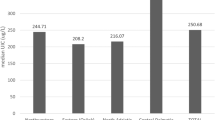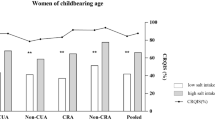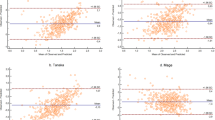Abstract
Background/objectives
Iodine deficiency and excessive salt intakes have adverse health consequences. The objective was to measure sodium and iodine concentrations in urine spot samples among a representative sample of Belgian adults and compare those to World Health Organization (WHO) recommendations.
Subjects/methods
Spot urine samples were collected in 2018 from participants of the Belgian Health Examination Survey. Iodine and sodium concentrations were measured by inductively coupled plasma mass spectrometry and ion selective electrodes respectively. Tanaka and INTERSALT equations were used to predict 24-h urinary sodium excretion using sodium and creatinine concentration in spot samples, sex, and measured height and weight.
Results
Median urinary iodine concentration (UIC) among adults (n = 1092) was 93.6 µg/L, indicating mild iodine deficiency according to WHO thresholds. Median UIC among participants who reported thyroid problems over the last year was significantly higher than among those who did not report thyroid problems (104.1 µg/L versus UIC = 92.2 µg/L, p < 0.001). There were no significant differences in median UIC between sexes, age groups, and regions. The average salt intake among Belgian adults (n = 1120) was 8.3 ± 0.1 g/day using the Tanaka equation and 9.4 ± 0.1 g/day using the INTERSALT equation. For both equations, <5% of the population met the recommended WHO upper salt intake level of 5 g/day.
Conclusions
Iodine nutrition in the Belgian adult, nonpregnant population likely indicates mild iodine deficiency as the median UIC was below the WHO threshold for iodine sufficiency. Salt intake was substantially higher than the WHO recommendations. Further policy efforts are needed to optimize iodine and reduce salt intake in Belgium.
This is a preview of subscription content, access via your institution
Access options
Subscribe to this journal
Receive 12 print issues and online access
$259.00 per year
only $21.58 per issue
Buy this article
- Purchase on Springer Link
- Instant access to full article PDF
Prices may be subject to local taxes which are calculated during checkout
Similar content being viewed by others
References
Zimmermann MB, Andersson M. Update of iodine status worldwide. Curr Opin Endocrinol Diabetes Obes. 2012;19:382–7.
Vanderpump MP, Lazarus JH, Smyth PP, Laurberg P, Holder RL, Boelaert K, et al. Iodine status of UK schoolgirls: a cross-sectional survey. Lancet. 2011;377:2007–12.
Trumpff C, De Schepper J, Tafforeau J, Van Oyen H, Vanderfaeillie J, Vandevijvere S. Mild iodine deficiency in pregnancy in Europe and its consequences for cognitive and psychomotor development of children: a review. J Trace Elem Med Biol. 2013;27:174–83.
Lazarus J. Iodine status in Europe in 2014. Eur Thyroid J. 2014;3:3–6.
Vila L, Puig-Domingo M. The Krakow declaration: the last chance for Europe to eradicate iodine deficiency. Endocrinol Diabetes Nutr. 2018;65:553–5.
Delange F, Van Onderbergen A, Shabana W, Vandemeulebroucke E, Vertongen F, Gnat D, et al. Silent iodine prophylaxis in Western Europe only partly corrects iodine deficiency; the case of Belgium. Eur J Endocrinol. 2000;143:189–96.
Vandevijvere S, Mourri AB, Amsalkhir S, Avni F, Van Oyen H, Moreno-Reyes R. Fortification of bread with iodized salt corrected iodine deficiency in school-aged children, but not in their mothers: a national cross-sectional survey in Belgium. Thyroid. 2012;22:1046–53.
Vandevijvere S, Amsalkhir S, Mourri AB, Van Oyen H, Moreno-Reyes R. Iodine deficiency among Belgian pregnant women not fully corrected by iodine-containing multivitamins: a national cross-sectional survey. Br J Nutr. 2013;109:2276–84.
Moreno-Reyes R, Glinoer D, Van Oyen H, Vandevijvere S. High prevalence of thyroid disorders in pregnant women in a mildly iodine-deficient country: a population-based study. J Clin Endocrinol Metab. 2013;98:3694–701.
De Ridder K, Bel S, Brocatus L, Lebacq T, Moyersoen I, Ost C et al. De consumptie van voedingsmiddelen en de inname van voedingsstoffen. In: Bel S, Tafforeau J, editors. Voedselconsumptiepeiling 2014–2015. Rapport 4. 2016. Brussels: Wetenschappenlijk Instituut voor Volksgezondheid; 2016.
GBD 2017 Diet Collaborators. Health effects of dietary risks in 195 countries, 1990–2017: a systematic analysis for the Global Burden of Disease Study 2017. Lancet. 2019;393:1958–72.
He FJ, Li J, Macgregor GA. Effect of longer term modest salt reduction on blood pressure: Cochrane systematic review and meta-analysis of randomised trials. BMJ. 2013;346:f1325. https://doi.org/10.1136/bmj.f1325.
Hoge Gezondheidsraad (HGR). Voedingsaanbevelingen voor de Belgische volwassen bevolking met een focus op voedingsmiddelen—2019. HGR NR 9284.
Hoge Gezondheidsraad (HGR). Voedingsaanbevelingen voor België—2016. HGR NR 9285.
Vandevijvere S, De Keyzer W, Chapelle JP, Jeanne D, Mouillet G, Huybrechts I, et al. Estimate of total salt intake in two regions of Belgium through analysis of sodium in 24-h urine samples. Eur J Clin Nutr. 2010;64:1260–5.
World Health Organization. NCD global monitoring framework. Geneva: WHO.
FOD Volksgezondheid. Convenant evenwichtige voeding. FOD Brussels: Volksgezondheid. https://www.health.belgium.be/sites/default/files/uploads/fields/fpshealth_theme_file/convenant_evenwichtige_voeding.pdf.
Nguyen D, Hautekiet P, Berete F, Braekman E, Charafeddine R, Demarest S, et al. The Belgian health examination survey: objectives, design and methods. Arch Public Health. 2020;78:50. https://doi.org/10.1186/s13690-020-00428-9. eCollection 2020.
Caldwell KL, Maxwell CB, Makhmudov A, Pino S, Braverman LE, Jones RL, et al. Use of inductively coupled plasma mass spectrometry to measure urinary iodine in NHANES 2000: comparison with previous method. Clin Chem. 2003;49:1019–21.
WHO and UNICEF. Iodine deficiency in Europe: a continuing public health problem. Geneva: WHO; 2007.
Brown IJ, Dyer AR, Chan Q, Cogswell ME, Ueshima H, Stamler J, et al. Estimating 24-hour urinary sodium excretion from casual urinary sodium concentrations in Western populations: the INTERSALT study. Am J Epidemiol. 2013;177:1180–92.
Tanaka T, Okamura T, Miura K, Kadowaki T, Ueshima H, Nakagawa H, et al. A simple method to estimate populational 24-h urinary sodium and potassium excretion using a casual urine specimen. J Hum Hypertens. 2002;16:97–103.
Kawasaki T, Itoh K, Uezono K, Sasaki H. A simple method for estimating 24 h urinary sodium and potassium excretion from second morning voiding urine specimen in adults. Clin Exp Pharm Physiol. 1993;20:7–14.
Mage DT, Allen RH, Kodali A. Creatinine corrections for estimating children’s and adult’s pesticide intake doses in equilibrium with urinary pesticide and creatinine concentrations. J Expo Sci Environ Epidemiol. 2008;18:360–8.
Huang L, Crino M, Wu JH, Woodward M, Barzi F, Land MA, et al. Mean population salt intake estimated from 24-h urine samples and spot urine samples: a systematic review and meta-analysis. Int J Epidemiol. 2016;45:239–50.
Tolonen H, Koponen P, Naska A, Männistö S, Broda G, Palosaari T. et al. Challenges in standardization of blood pressure measurement at the population level. BMC Med Res Methodol. 2015;15:33. https://doi.org/10.1186/s12874-015-0020-3.
Whelton PK, Carey RM, Aronow WS, Casey DE, Collins KJ, Himmelfarb CD, et al. 2017 ACC/AHA/AAPA/ABC/ACPM/AGS/APhA/ASH/ASPC/NMA/PCNA Guideline for the prevention, detection, evaluation, and management of high blood pressure in adults: a report of the American College of Cardiology/American Heart Association Task Force on Clinical Practice Guidelines. Circulation. 2018;138:e484–e594. https://doi.org/10.1161/CIR.0000000000000596.
Titze J. Estimating salt intake in humans: not so easy!. Am J Clin Nutr. 2017;105:1253–4. https://doi.org/10.3945/ajcn.117.158147.
Meyer HE, Johansson L, Elise EA, Johansen H, Holvik K. Sodium and potassium intake assessed by spot and 24-h urine in the population-based Tromsø Study 2015–2016. Nutrients. 2019;11:1619
Acknowledgements
The authors would like to thank Frédéric Van Steen for his skillful technical assistance for iodine analysis. The authors thank all individuals who participated in the BELHES2018.
Funding
The BELHES2018 was funded by the National Institute for Health and Disability Insurance (RIZIV/INAMI).
Author information
Authors and Affiliations
Contributions
SV performed the statistical analyses and wrote the paper. AR, AW, CM, and JVL performed the laboratory analyses. PH organized the fieldwork of the BELHES2018. RM-R helped with interpretation of the iodine nutrition results. JVH coordinated the BELHES2018. All authors critically commented on and approved the final version of the manuscript.
Corresponding author
Ethics declarations
Conflict of interest
The authors declare that they have no conflict of interest.
Additional information
Publisher’s note Springer Nature remains neutral with regard to jurisdictional claims in published maps and institutional affiliations.
Rights and permissions
About this article
Cite this article
Vandevijvere, S., Ruttens, A., Wilmet, A. et al. Urinary sodium and iodine concentrations among Belgian adults: results from the first national Health Examination Survey. Eur J Clin Nutr 75, 689–696 (2021). https://doi.org/10.1038/s41430-020-00766-5
Received:
Revised:
Accepted:
Published:
Issue Date:
DOI: https://doi.org/10.1038/s41430-020-00766-5



